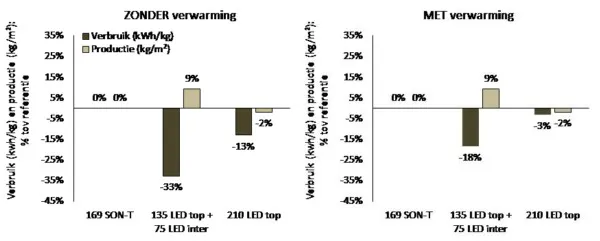To be able to grow tomatoes year round in the Netherlands and Belgium, light is required. In winter, sunlight alone is not enough, so growers opt for lighting. But what is the best choice, LED or SON-T? Proefcentrum Hoogstraten is executing a test that will run until October.
The lighting most opted for is SON-T at the moment. These lamps are not very energy efficient. Besides producing light, these lamps produce a lot of heat. LED lamps are much more efficient in converting electricity to light. Moreover, the spectrum is much easier to adjust to the needs of the plant and they last must longer. The interest in LED lighting for tomato cultivation is, not surprisingly, high.
Test set-up
Last winter, a greenhouse was equipped with only LED lamps (210 µmol/m²s ) at Proefcentrum Hoogstraten, in which a distinction was made between full top light and the combination top light (135 µmol/m²s) and inter light (75 µmol/m²s). In another greenhouse, SON-T lamps (169 µmol/m²s) were installed.
In this way, a cultivation with only LED lighting is compared to tomato cultivation with SON-T lamps, which is still the most common way for winter cultivation. This test focuses on plant growth, production, and energy use.
On October 17, 2018, tomatoes were planted in both greenhouses. The choice was made for Merlice, grafted and topped on Maxifort. In the greenhouse with SON-T lamps, they started with 2.5 p/m2. The final stem distance is 3.33 p/m2.
In the Full-Led set-up, planting was a bit closer (2.76 p/m2) and went up to ultimately 4.6 p/m2 because previous tests already showed that LED increased the fruit weight.

First results
Half April, the moment the SON-T lamps had to be turned off because of excessive radiation heat, the first overview of the results were made. With the combination LED top and inter light, 9% more tomatoes were produced than in the reference system with only SON-T lamps, because more fruits per m2 were harvested due to the higher stem density and a higher average fruit weight.
If only LED top light is used, the production in winter is 2% lower than in the reference system. Here also were more fruits per m2 harvested because of the higher stem density. The fruit weight of these tomatoes was 20 grams lower on average than in the Full-LED system with inter light. It seems that it is mostly the LED inter light which increases the fruit weight of the tomatoes.
Energy consumption
When the researches only look at the energy use and only take the energy consumption of the lamps into account, the Full-LED lighting system uses 13% (top light) to 33% (combination top light and inter light) less electricity per kilogram tomatoes produced when compared to the reference system. The difference was partly in the lower production in the Full-LED system with only top light and partly in the efficiency of the lamps. The top light modules contain a little white light to make the greenhouse more agreeable to employees, but this also makes the lamps a bit less energy efficient.
When the researchers also take the energy consumption for heating into account, a Full-LED system is still more energy efficient than the reference system. Because more heating is required in a Full-LED system to achieve the same temperature as the reference system, the difference in energy use with the reference system is smaller. Still, 3% (top light) to 18% (combination top and inter light) less energy is used per kilogram tomatoes used.
Final results beginning of October
Since half April, the SON-T lamps have been definitively turned off. The LEDs, however, can keep burning if the natural radiation between 04.00 and 13.00 is lower than 400 W/m2. At the moment, the production in both Full-LED systems is higher than in the reference system. The difference between only top light and the combination top and inter light is unchanged. The effect on the total production and energy consumption will be known at the beginning of October.
This project is realised with support of the European Union.
Source: Glitch
